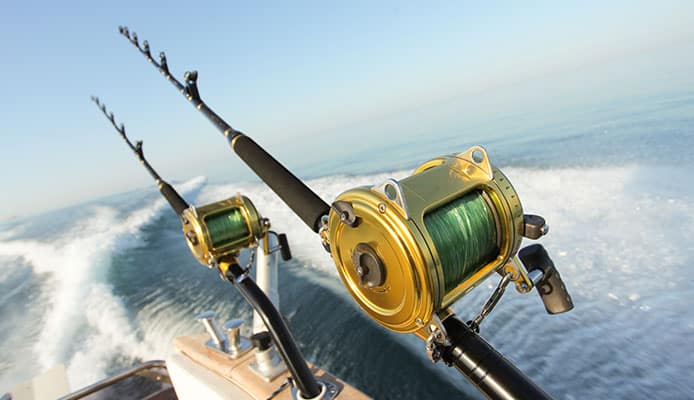
-
1.
-
2.
-
3.
-
4.
-
5.
Having the best fishing rod and reel well matched to use the same fishing line and work together flawlessly is key to successful and enjoyable fishing excursions. Such a well-balanced rig feels good in your hands and gives you control for a smooth experience when casting, fighting fish, and retrieving.
The easiest, quickest and cost-effective way to get a compatible setup, especially if you’re a beginner, is to go with a ready-made combo where the manufacturer has already done the hard work and put together a balanced outfit for optimum performance. This way, you won’t be overwhelmed with details trying to figure out what goes with what or which rod and reel specifications match.
All you have to do is pick the best combo for you, add a suitable fishing line, lures, and baits and you can head out to the water, catch fish, and have fun. The best approach to ensure you get the best rod and reel is to choose among the best outfits. Here, we’ve reviewed the top-rated rod and reel combos that work great together. Read on to find the perfect combo for you depending on your needs.
OUR TOP PICK
Ugly Stik GX2 Spinning
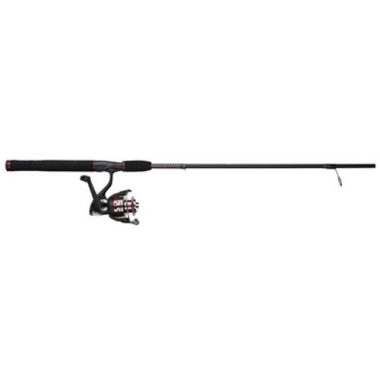
- Stand Out Features - Why We Love It
- Very strong, flexible and sensitive rod
- Smooth reel casts great
- Tough and durable construction
- Well balanced components and set-up
- Great price and excellent value
EDITORS CHOICE
PLUSINNO Carbon Fiber Telescopic
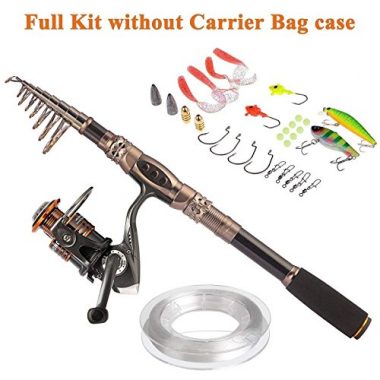
- Stand Out Features - Why We Love It
- Complete fishing kit with rod, reel, and tackle
- Telescopic rod collapses easily for convenient transport and storage
- Versatile as equipped for salt and freshwater fishing
- Outstanding value for the money
- The rod comes in a variety of lengths
- Anti-corrosive construction
- Strong and sturdy rod plus smooth reel
- Attractive hi-tech looking outfit
BEST VALUE
Okuma VS-605-20 Spinning
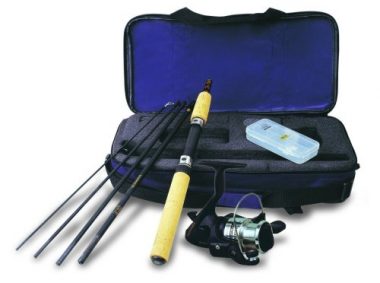
- Stand Out Features - Why We Love It
- Compact package for convenient storage and portability
- A lot of gear for an inexpensive price makes it great value
- Perfect for trout, panfish, bass, catfish and walleye fishing,
- Easy to put together and use
- A lightweight outfit that is comfortable to carry and use
- 5-Piece travel rod breaks down easily for compact storage and travel
- Great quality fishing kit
- Comes with a soft-sided carry case and a tackle box
Penn Pursuit II & III
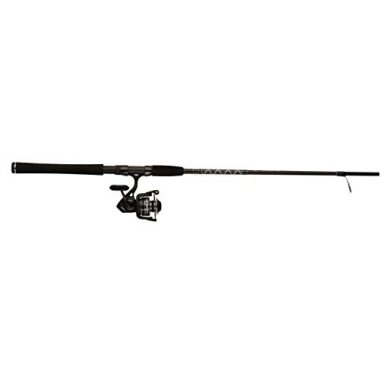
- Stand Out Features - Why We Love It
- Equipped for saltwater fishing
- Corrosion resistant construction
- Well crafted and high quality rod
- Top quality, heavy-duty and smooth reel
- Well-balanced, lightweight and comfortable outfit
- High quality combo with great pricing
- Excellent value for the money
Wakeman Swarm Series
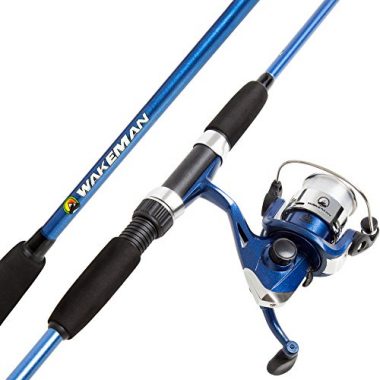
- Stand Out Features - Why We Love It
- Attractive design and blue metallic look
- Inexpensive pricing and good value
- The spool comes with monofilament fishing line already added
- Good quality and durable
- Easy to use and delivers a smooth operation
- Lightweight and comfortable to handle and use
Eagle Claw PK56TS Pack-It Spin Combo Telescopic
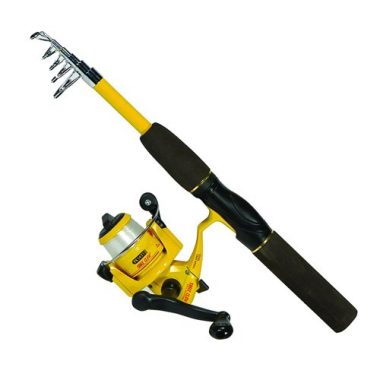
- Stand Out Features - Why We Love It
- Comes with fishing lines already spooled
- Telescopic rod for convenient storage and portability
- Affordable pricing
- Lightweight with comfortable handling
- Rod casts great and reel action is smooth
- Works well with lures and baits
- Convenient and easy to carry wherever you go
PENN Battle II Combo
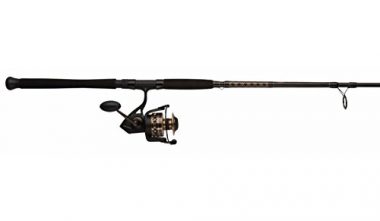
- Stand Out Features - Why We Love It
- Long lengths rods for casting farther
- Powerful and smooth reel action
- The spool accommodates braided lines without a hassle
- Equipped for saltwater fishing
- Powerful drag washers are greased for durability
- Strong and durable construction
- Rod has excellent sensitivity
- Impressive quality and excellent value
Penn Spinfisher V Spinning
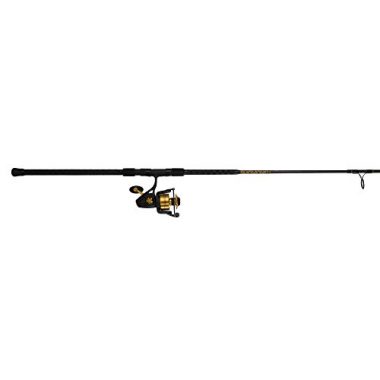
- Stand Out Features - Why We Love It
- Comfortable to hold EVA grips
- Accommodates braided lines directly
- Equipped for heavy duty and corrosive saltwater fishing
- The powerful and smooth drag system
- Strong and durable construction
- Both rod and reel are top of the line quality
- Sturdy, responsive, comfortable and powerful rod
- Delivers excellent castability and reeling performance
- Internal components are shielded in a watertight construction
Daiwa Mini System Minispin Ultralight
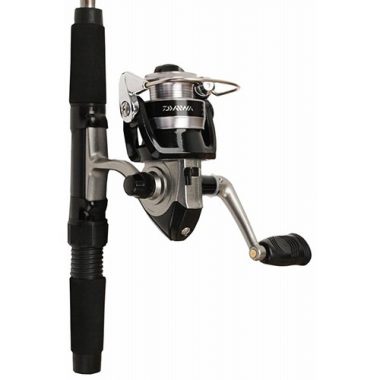
- Stand Out Features - Why We Love It
- Easy and quick to assemble
- It is very affordable
- Small and compact combo
- Five-piece system rod is easy to pack and carry around
- Lightweight and easy to carry and use
- Well thought out and well built
- Durable and hard wearing
- Comes with an ultra-compact hard case with tackle compartments
- Limited manufacturer's warranty
Pflueger Trion
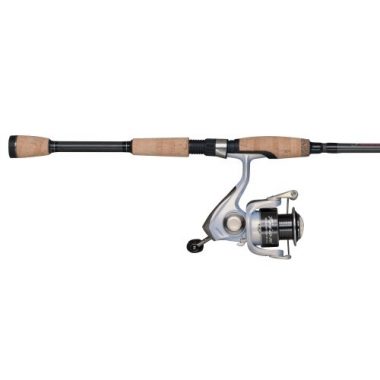
- Stand Out Features - Why We Love It
- Plenty of ball bearings for a smooth operation
- Well made with durable and corrosion resistant components
- Lightweight, balanced and comfortable to fish with
- Attractive appearance
- Easy to rig up and use
- Smooth casting and reeling
- Great price and amazing value
- The smooth and powerful drag system
- Sensitive and responsive pole
How To Choose A Fishing Rod And Reel – Buying Guide
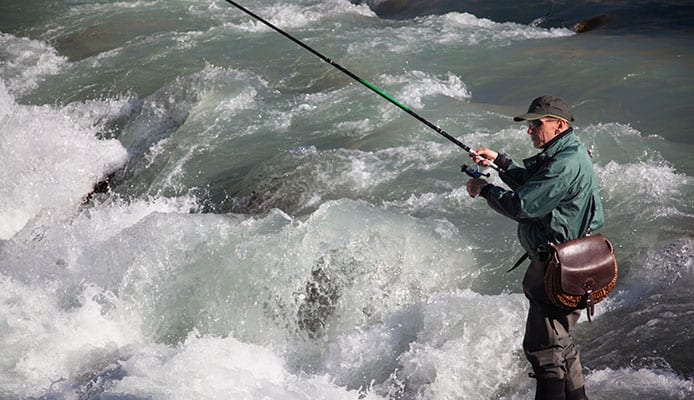
While buying a fishing rod and reel combo saves you from the hard work or guesswork involved when assembling a rod and reel outfit on your own, you still want to ensure you’re picking the right combination of rod and reel for where you’re fishing, what you’re catching, how you’re catching it, and for the money.
Understanding how a rod’s and reel’s features and specifications affect its performance when fishing will help you choose the right fishing rig for your needs. Here are the features and specifications to check when buying your reel and rod set to ensure you get a good one that will serve you well out there.
When judging the fishing rod in the combo, consider the rod’s action, power, responsiveness, and guides as follows:
Action
The action of a fishing rod refers to where a rod bends when there’s load applied on its tip. It describes how stiff or flexible the pole is, where it begins to bend, how much it flexes along its length and how quickly the tip returns to normal when pressure is removed.
A rod’s action may be slow, medium, fast, extra fast, or in between. It is affected by the rod’s taper/thickness, length, and the blank material.
A rod’s action affects its castability and the level of control you have over the fish. Different types of action are better suited to different types of lures, baits, and fish as follows:
Extra Fast Action
Extra fast action fidhing rods are the least flexible and bend just at the tip with very little bend throughout the rod length. With their stiffness, they are quite sensitive at the tip and can put a lot of pressure on a fish. They are best suited for bigger fish, larger lures, and fishing in heavy covers such as vegetation or wood.
Fast Action
Fast action rods are more flexible and bend in the top third or less from the tip. They provide both power and flex and are more sensitive. They are very good for short to long casting distance, single hook lures as they set the hook hard, topwater baits, plastic worms, soft sticks, jerk baits, and spinnerbaits. They are great for pike, musky, and largemouth bass and can handle large game fishing and heavy cover or weeds.
Moderate Action
Medium or moderate action fishing rods bend in the last half from the tip all the way to the middle. They offer great control for casting farther and offer a lot of hook setting power making them great for treble hooks such as crankbaits, topwater lures and spinnerbaits as their slower action enable a hard hook set. They are also versatile and suitable for a variety of species and fishing situations.
Related Review: Crankbait Rod
Slow Action
Slow action rods are the most flexible and bend uniformly throughout the rod length. They have a parabolic bend. They’re best suited to smaller fish, lighter lures and baits, and soft or live baits. They also act as shock absorbers for light lines ensuring the hook does not tear out of the fish’s mouth when using treble hooks.
Power
The power of a fishing rod describes its lifting strength/backbone and how much weight it can sustain without snapping. Rod power is described as heavy, medium-heavy, medium, light, or ultra-light.
Rod power determines the fishing line pound test and lures weights you can use with it and the fish species and fishing situations it can handle.
Ultra-light and light power rods are highly responsive but don’t have a lot of lifting power. They’re suitable for small bait fish, lightweight fishing lines and lures, freshwater fish, and fishing in clear, open water.
Heavy power rods are strong and have the lifting power to handle heavy and large fish. heavy fishing lines and lures, deep sea fishing, surf fishing, and fishing in thick, heavy cover.
You might also be interested in:
Medium power rods are versatile and can handle a range of small to larger fish sizes, line and lure weights, and light to moderate cover.
Responsiveness
The responsiveness of a fishing rod describes how it flexes under load to store energy and how quickly it releases this stored energy when casting.
The materials the rod is made of, its weight, and modulus/stiffness all play a part in how responsive the rod is.
The lighter the rod, especially at its tip, the more responsive it is. High modulus rods store and release energy more efficiently, which enables them to cast more efficiently and accurately effortlessly.
Guides
Guides are positioned on the rod’s shaft to hold the fishing line away from the rod blank and control its movement. They allow the line to flow smoothly and with minimal friction allowing the angler to cast better.
The guides should be placed properly to spread out the stress applied to the rod blank when fighting fish. Rods in baitcaster combos have the guides located on the top side of the rod while spinning rods have the guides located on the underside of the rod.
The more guides a rod has, the better it performs, as pressure is applied more consistently throughout the pole utilizing its full strength when casting and fighting fish. Fuji Guides use this system to increase casting distance and reduce line twist. However, more guides mean a higher price tag.
The material used to make the guides and quality of construction of the guides determine how durable and corrosion resistant the rod is.
Silicon carbide (SiC) is considered the best material because of its super-smooth surface which minimizes friction on the line making it possible to cast farther and retrieve quickly and extending the line’s lifespan. Alconite, aluminum oxide, titanium, stainless steel, and ceramic materials are also used.
To determine how good the fishing reel in the combo is and how well it will perform, pay attention to the reel’s ball bearings, gear ratio, and drag system as follow:
Ball Bearings
Ball bearings are stainless steel or ceramic balls that help reduce friction, noise, and vibration in the moving parts of a reel. The quality of a reel is heavily dependent on whether it has a bearings system and the amount and quality of ball bearings it has.
The more ball bearings a reel has and the higher their quality, the smoother the retrieves and reel-ins will be and the easier it will be to cast precisely. However, the higher the price tag will be. Reels with a lower bearing count have a price advantage but aren’t as smooth and reeling in a big fish will be a jerky experience.
The best fishing reels have four to six or more ball bearings. For the smoothest reel performance especially if going after big fish, buy a reel that has the highest ball bearing count and quality within your budget. Go for at least five.
For saltwater fishing reels, it is important that the ball bearings have a corrosion resistant construction and sealing to keep away saltwater and sand. The best bearing systems also have a high quality lubricant, which makes the bearings durable and the reels smoother.
Gear Ratio
The gear ratio of a reel indicates the number of revolutions the spool makes with each turn of the reel’s handle. This ratio will determine how much cranking power the reel has and how fast you will be able to retrieve line.
A low gear ratio such as 4:1 will be easier to turn but will require more turns to retrieve line thus its line retrieval will be slow. The benefit of a low gear ratio is that it offers more cranking power and leverage, which is what you need to haul large fish out of deep water.
A high gear ratio such as 6:1 offers more speed and retrieves line faster. It is ideal for quick moving bait, retrieving smaller fish, fishing with top-water plugs or spinners, and for pulling in long line lengths when trolling.
If you’re not sure what will work best for you, you can go for the happy medium of 5:1 to get a good retrieval speed and power as well.
Drag System
The drag system on a reel is composed of a series of disks/washers connected to the spool. Large, strong, and hard fighting fish put a lot of strain on your rod and line. The drag system is designed to bear some of that strain before the line or rod breaks.
The drag determines the resistance a fish needs to overcome to pull line from the reel in order to ease the extreme pressure on the line, the rod and the angler while tiring the fish at the same time. If there is too much resistance to pulling the line, the aggressive fish might snap the line. Too little resistance will make it hard to reel in your catch.
A strong drag system is essential for larger game fish like Tuna and Marlin and fishing in deep waters and cover.
Because of the way the drag system works, overheating can become an issue. The best drag systems have heat dissipation and ventilation features. Carbon fiber is the best material for drag washers because it dissipates heat effectively.
It’s also important to ensure that the drag system adjusts easily and smoothly and is tight enough to stay where it’s adjusted. Front mounted drag system are considered higher quality and offer the durability needed when fighting larger fish while rear drag systems are easier to adjust.
FAQs
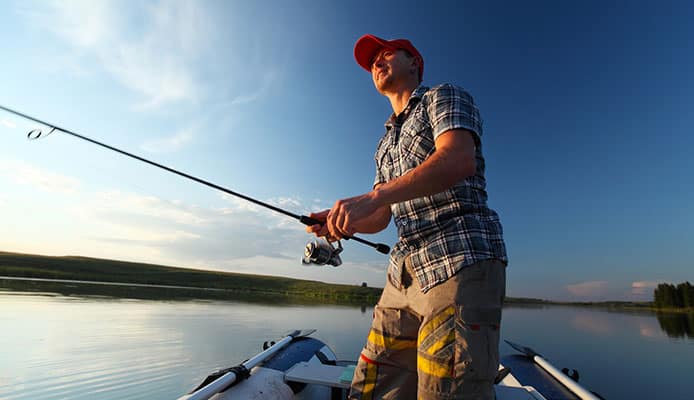
Q: Should I Get a Rod and Reel Combo Or Get Them Separately?
Some passionate anglers love taking on the challenge and assembling their own custom rod and reel combination to satisfy their unique fishing needs. Others prefer to avoid the hassle of getting their rod and reel separately and appreciate the convenience ready-made fishing rod and reel combos offer.
Rod and reel combos are great for beginners, those on a budget, and any fisherman who wants to grab a ready to fish outfit quickly. Experienced anglers who know exactly what they want in their fishing rig and can match the specifications on their own will derive more satisfaction from getting a rod and reel separately.
However, there are times when a novice may find it best to purchase a rod and reel separately and an experienced angler be better suited by a ready to go combo. Consider the following factors when deciding whether to get a rod and reel combo or get them separately.
Q: What is Your Level of Knowledge and Experience?
Experienced
You can’t just attach any reel to any rod and expect a satisfactory performance. You have to create a well-balanced rig that works perfectly together. To purchase a rod and reel separately and put them together on your own requires knowledge and experience.
As an experienced angler, you already know what you want and what brands and models work best for you. Buying a rod and reel of your choice and putting these together will offer you more satisfaction. Ready-made combos might disappoint you as they might not offer the exact specifications and superior performance you’re looking for.
A: Beginner
If you’re just starting out in angling and this is your first rig, you will not know how to assemble a well-balanced outfit. Choosing a rod and reel among the wide variety of fishing rods and reels in the market can be overwhelming enough. Figuring out what reel and rod specifications match can prove to be very daunting.
You may end up giving up or choosing components that don’t work well together making everything difficult for you when you go fishing. You don’t want your first experience angling to be a difficult one, as this might kill your interest in it completely.
As a beginner, combos are the best way to go so you can get to the fun part immediately. The manufacturers have already done the hard work for you and assembled a rod and reel setup that will work together smoothly making your first fishing excursion a pleasant one and your learning curve easier and enjoyable.
When you’re ready for an upgrade, you can purchase a rod and reel separately, as you will have more experience and knowledge of what works best with what and what specs you need for your favorite species or fishing style.
B: How Much Time Can You Dedicate to Your Purchase?
A: There are so many fishing rods and reels in the market that choosing each separately will definitely take time as you research and shop around. Whether you’re a beginner or a seasoned angler, purchasing a rod and reel separately and ensuring you make compatible choices will take you more time.
It will take you a considerable amount of time if you’re a novice and have to start by learning all the basics such as the difference between a baitcaster rod and reel and a spinning rod and reel.
If you’re willing to take your time to do your research and gain the knowledge you need to get your most important fishing gear separately and ensure they work together, you can go ahead and purchase them separately. When you create the perfect setup for yourself, you’ll be very happy with your approach and immensely satisfied with the results.
If you don’t have all that time to spend researching and learning and just want to grab something reliable quickly and head out to the water, a rod and reel combo is the best option for you.
B: What Is Your Fishing Type/Style?
A: If you’ve specialized in an unusual fishing style and go after uncommon fish species that require unusual methods to catch them, you’ll be best served by purchasing a reel and rod separately, as this will enable you to create a specialized kit best-suited to your unique needs.
If you catch the popular fish species such as bass, catfish, trout, and crappie or want a versatile rod and reel kit that works for a variety of species and fishing situations, you can go for a specialized combo such as an ice fishing or fly fishing rod and reel combo or a general combo that will suit all common fishing situations.
Related Reviews: Catfish Rods & Crappie Rods
If you already have your main rod and reel combo and want a smaller outfit for backpacking and travel so you’re always ready to fish when the chance presents itself, a fishing rod and reel combo designed for travel is your best option.
If you want to try a new style or type of fishing but aren’t sure it will be your thing, an inexpensive combo is an excellent way to test the waters.
B: How Much Are You Willing To Spend?
A: Rod and reel combos tend to be more affordable than purchasing the components separately. If you’re on a budget, you’re better off with a ready-made combo. Purchasing a rod and reel separately will require you to spend more money.
B: Which Is Your Preference?
A: Deep inside, you already know which approach will give you the most satisfaction with your most important fishing gear. Whether you just prefer the convenience a combo offers or want to take your time, get a rod and reel separately and assemble your own custom rod and reel outfit, follow your gut and go with it.
Q: How Should I Clean My Reel And Rod?
Your reel and rod are a valuable investment that you want to benefit from for a long time. To keep them in good condition and keep corrosion at bay, it’s very important to gently clean your reel and rod after every fishing excursion, especially after saltwater use. Here’s how to clean your reel and rod properly.
Q: How To Clean Your Reel?
Gently rinse your reel with fresh water to eliminate sand, grit, dirt, and other loose residues from its surface.
Sponge it lightly using warm soapy water and use a small toothbrush for gentle yet effective cleaning. Never immerse your reel in water or use a high-pressure water spray to clean it, as this will allow water to get into and damage the gearing and drag systems.
Let it dry and then gently wipe any residue with a clean cloth.
Lightly spray or wipe the reel with a lubricating surface protectant.
To clean the underside of the spool, undo the drag knob, slide off the spool and clean it. Lightly grease the main shaft and replace the spool and drag knob. Lubricate the handles, rollers, and bail springs with reel oil. It’s also important to grease the bearings and gears every now and then.
Loosen the drag knob to keep pressure off the drag washers when in storage.
Once in every while, open the side plate and grease the bearings and gears lightly.
Once a year or if immersed in saltwater, give the reel a full service by completely dismantling all parts, cleaning and lubricating them. If you’re unfamiliar with the reel’s inner workings and are not completely confident to do this yourself, have it serviced by a qualified reel technician.
Q: How To Clean Your Rod?
Gently and thoroughly rinse your rod with fresh water to remove sand, grit, dirt, and residue.
Clean the grips and other parts carefully and use warm soapy water to remove all sticky dirt. Use a cloth, toothbrush or soft-bristle brush and a mild biodegradable cleaner to remove stubborn residue.
Pay special attention to the guides while cleaning, as these are susceptible to corrosion.
Allow your rod to fully dry and then gently wipe off any remaining residue with a soft cloth
Lightly spray or wipe the rod with a lubricating protectant. Apply a light reel grease on rod guides to prevent corrosion.
For 2pcs and more rods, use paraffin or candle wax to rub the joints (ferrules) where the sections come together to prevent friction.
Q: How Should I Store My Reel And Rod?
After cleaning your reel and rod, letting them dry completely, and lightly greasing where necessary, it’s time to store them properly so as to ensure you find them in good condition the next time you’re going fishing. After saltwater use, remember to remove the fishing line from your rod and reel before storage.
How To Store Your Rod
Fishing rods are long, delicate and susceptible to damages. The tips break off easily and the blanks weaken and bend easily.
Put rods in their covers or sleeves and store them on rod stands to prevent them from curling, leaning, or bumping into each other and tangling.
Keep your fishing rods on a rack-mounted vertically or horizontally and away from the elements to prevent curvature or damage. Don’t lean them in a corner, as they might weaken and bend.
Never leave your rod or reel in your car, boat, or truck where it is exposed to extreme heat or cold or lay it over something hard where it will bounce, as this will weaken it.
How to Store Your Reel
Remove the reel from the rod and ensure the drag knob is loose to keep pressure off the drag washers while the reel is not in use.
Keep your reels protected by storing them in reel covers. You can also wrap them in a towel or an old sock.
Store your reels in a reel bag or tackle bag where they won’t be disturbed and away from the elements.
Globo Surf Overview
As an angler, your fishing rod and reel are the most important as well as the most expensive equipment. It is very important that the two are compatible in order to work well together. Ready-made combos make getting a perfectly matched rod and reel pair easy and cost-effective. You don’t have to figure out what fishing rods specifications go with what reel specifications on your own.
All the best fishing pole and reel combos featured above are well balanced to work together effectively and efficiently delivering the best performance on the water and allowing you to experience success casting and reeling while enjoying yourself. By reading the review for each fishing rod and reel combo, you’ll be able to pick the one combo that suits you best whether you’re looking for a travel-friendly combo or a saltwater fishing outfit.
To be sure you’re getting the right rod and reel setup, keep in mind your target species, where and how you fish and understand how the rod and reel specifications affect performance when fishing.
Once you’ve found the best fishing pole and reel, you can start fishing right away! All you have to do is add a fishing line that matches the rod’s capabilities and reel capacity and get the lures and baits that attract your target fish species. Then you can look forward to a lot of good fishing and fun on all your fishing trips.
More Fishing Rods Reviews:
- Catfish Rods
- Surf Fishing Rods
- Crappie Rods
- Saltwater Fishing Rods
- Kids Fishing Poles
- Crankbait Rods
- Jigging Rods
- Telescoping Fishing Rods
- Dropshot Rods
- Jerkbait Rods
- Baitcasting Rods
- Spinning Rods
- Fly Fishing Rods
More Rod Reviews:
What is your favorite fishing rod and reel combo? Do you think getting a ready-made combo or buying the reel and rod separately is best? Please share with us your experience by leaving a comment below.


